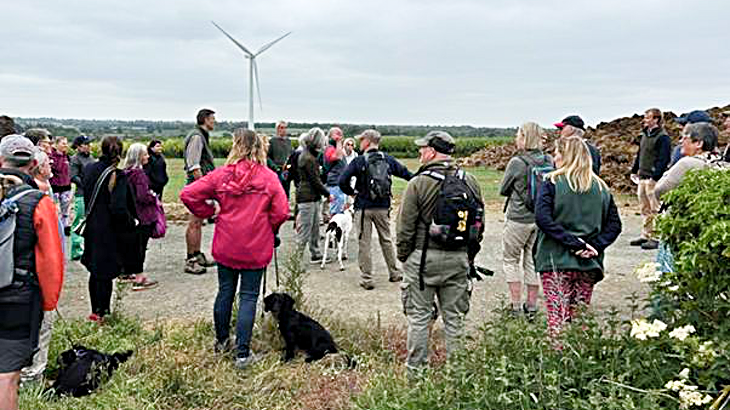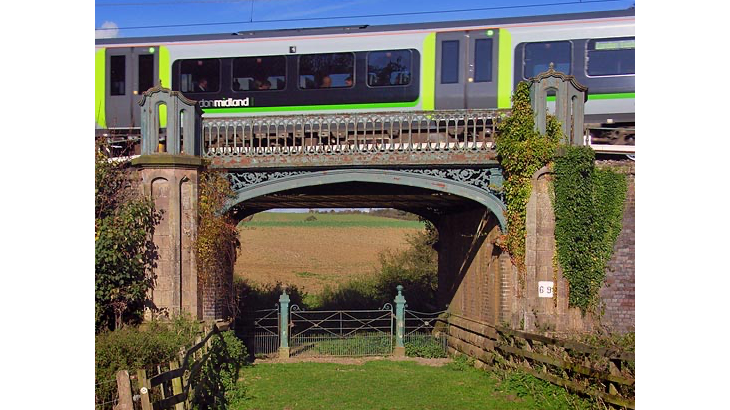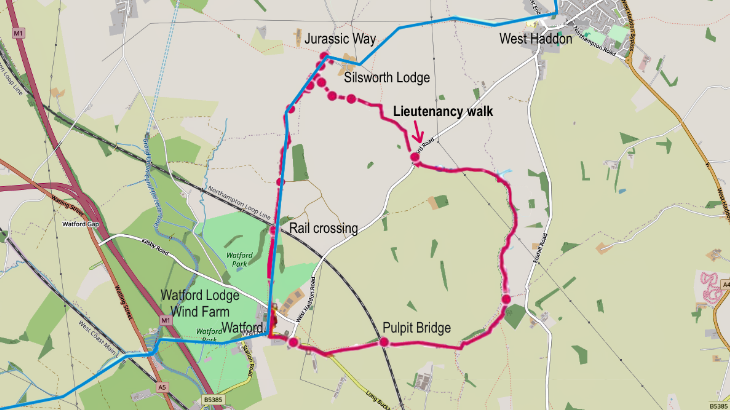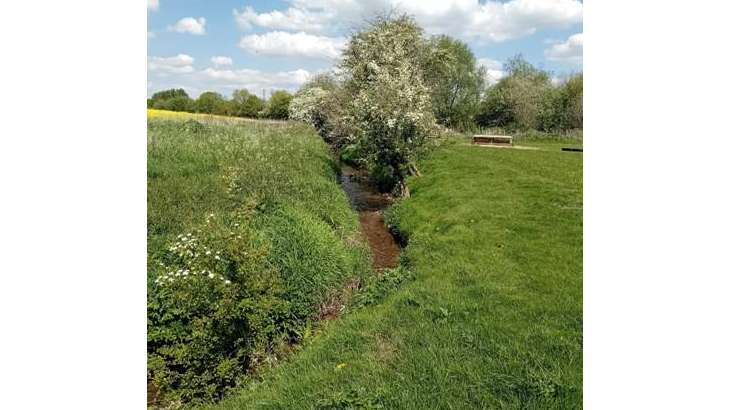Lieutenancy Climate and Sustainability Walk; Saturday 17 May, 2025

After a chilly start, it turned into a glorious day with hedges and ditches a froth of white, hawthorn and cow parsley, meadows with jewels, buttercups and campion, and dark woods carpeted in sinister garlic mustard. Although we did not count, some thirty people set off shepherded by guides from Northamptonshire Walks and HM Lord-Lieutenant of Northamptonshire himself, James Saunders Watson Esq. The walk was planned by Deputy Lieutenant, John Brownhill, and David Askew of Northamptonshire Walks, with assistance from Jane Wood of CA-WN and Ruth Rolls, Nature Recovery Strategy Officer for West Northants Council. The aim was to provide an opportunity for climate and environmental groups to get together, get to know one another and exchange ideas.
There was a short and a long circular route starting from the Payne's farm shop at Silsworth Lodge, near Crick. After coffee and a brief introduction by James Saunders Watson, we set off on a hike across fields of wheat and oil-seed rape to the wind farm on Watford Lodge Farm.
Wind Turbines
The five massive turbines became operational in 2015, the last of the current generation of land-based wind farms. Northamptonshire farmer Jim Beaty was unable to give the scheduled talk at this point, but his son stepped in and gave a really comprehensive review of wind turbines and their place in our fight against climate change. As this is such an important topic, we hope to borrow his notes to write it up separately in CA-WN Exchange. However, at this point I should mention that we were all impressed by the almost silent passage of the giant aerofoil blades slicing through the air.
Pulpit Bridge
We continued through the wheat along the so-called ‘Jurassic Way’ to the ‘Pulpit Bridge’ under the Northampton Loop railway.

David Askew gave us a most interesting talk on the background to this historic bridge built in 1877 to bring the new Northampton Loop railway through the estate of Watford Court. Bisecting the grand North Ride, the line was not that popular with local nimbys. Not only did it cross the Ride, it also interfered with the annual Rogation Sunday service to bless the crops. Local peer, 3rd Baron Anthony Henley, was able to preach from the pulpit to parishioners on the estate. He was also able to catch the train to reach his seat in the House of Lords. You can read much more about this local railway treasure in an article on the website written by David Askew himself.

Across the tracks
From the railway bridge we followed the Jurassic Way. A majestic avenue of limes led through lovely parkland shared by some fine black and white cattle (very calm!) until we reached the main road in Watford. We were safely marshalled with expertise by the Northamptonshire Walks Guides until we struck off again east across the fields. But the Guides were needed once more when we re-crossed the railway. From the map, you can see that the railway line follows a gentle bend meaning that you cannot see far in either direction. In addition the cutting and embankment were covered in rough coppice and scrub. It is many years since I have crossed a main railway on foot and I was quite nervous. We stopped to let one train thunder through sounding its klaxon but we were not quite so ready for its mate following immediately in the opposite direction.
Following field margins, it was interesting to see the varying widths and where herbicides had been used to restrict noxious weeds creeping into the crops. There are so many different treatments for field margins according to whichever ELMS grant scheme the farmer is following. There were no wildflower mixes sown, but the distance to the stream was mostly sufficient to minimise spray drift from the crop.
Nature Recovery
We stopped and sat by the stream in a beautiful buttercup and wildflower meadow in view of Vanderplank’s Covert. (Difficult to identify exactly on the map, but where the route veers north again toward Foxhill.) Ruth Rolls – West Northants Nature Recovery Strategy Officer – explained her team’s strategy and has kindly sent us a copy of her rough notes. She also took some great photos. I have copied one below showing hawthorn shading and cooling the water. By the time you read this, Ruth will have delivered a talk on Nature Recovery to CA-WN’s monthly meeting describing her team’s work in general, but if you were on this walk and would like a copy of her notes, I am sure she would not mind me sending them to you.

Ruth explained that this walk is in the Northamptonshire Uplands:
The Northamptonshire Uplands is an area of gently rolling, limestone hills and valleys capped by ironstone-bearing sandstone and clay-lias, with many long, low ridgelines. Rivers flow out from the uplands in all directions, including the headwaters of the Cherwell, Avon, Welland, Tove, Ouse, Nene and Ise. While there are areas of differing character, there are strong unifying landscape features. Most notable features include: the extensive areas of open field systems with ridge and furrow; high, wide, A-shaped hedgerows with frequent mature ash and oak trees; the many country houses and their associated extensive areas of historic designed parkland landscapes; and the small, scattered but prominent broadleaved woods and coverts.
Agriculturally it is varied and moderately productive. Some good arable land for food production and some good pastures for livestock. It is surprisingly short of woodland but many hedgerow trees compensate to some extent. From the point of view of nature, there is a lot of room for improvement on farms and also in gardens and public areas. Very few farms have irrigation and there is virtually no horticulture. Changes could not only benefit wildlife, but also improve flood prevention, water quality, and public reservoirs. There is much to do for Ruth and her team. For woodland, they use the Lawton approach which is summarised as better, bigger, more joined up, pressure.
The Payne’s farm at Silsworth Lodge
After walking for four and a half hours, many of us were either knackered or had other engagements and melted away. This was sad as the Payne family had prepared a talk about farming. I returned to meet the Paynes a few days later. Katie was busy shearing sheep.
After all the Nature Recovery talk, I was expecting a farmer’s more traditional view: the importance of food production and self-sufficiency. Not at all. Two thirds of the 550 acres are grazed and there are 67 acres of arable. Apart from meat for the small farm shop, the main outputs are wild flowers, either grazed or for hay, and bird food, kale, millet, black-eye beans, sorghum and sunflowers. No insecticides are used. Some income comes from a pest control business. I was a bit confused as to income source and how they manage the various schemes (stewardship and sustainable farming incentive), but the overall impression was the family’s relief and contentment from seeing wildlife return to the farm.
Well we shall see! Luckily some farmers are committed to feeding us all. But all farmers would like to see more larks and owls and finches too.
Looking at brown fields in mid-July, it is lovely to remember this glorious walk in May. Thanks to all who had a part in organising it and I hope we can repeat next year.

